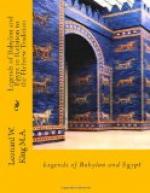(1) Cf., e.g., Jastrow, Hebr. and Bab. Trad., p. 329.
(2) Gilg. Epic, XI, ll. 28-30.
(3) L. 58 f. The gar contained twelve cubits, so that the vessel would have measured 120 cubits each way; taking the Babylonian cubit, on the basis of Gudea’s scale, at 495 mm. (cf. Thureau-Dangin, Journal Asiatique, Dix. Ser., t. XIII, 1909, pp. 79 ff., 97), this would give a length, breadth, and height of nearly 195 ft.
I do not think it has been noted in this connexion that a vessel, approximately with the relative proportions of that described in the Gilgamesh Epic, is in constant use to-day on the lower Tigris and Euphrates. A kuffah,(1) the familiar pitched coracle of Baghdad, would provide an admirable model for the gigantic vessel in which Ut-napishtim rode out the Deluge. “Without either stem or stern, quite round like a shield”—so Herodotus described the kuffah of his day;2() so, too, is it represented on Assyrian slabs from Nineveh, where we see it employed for the transport of heavy building material;(3) its form and structure indeed suggest a prehistoric origin. The kuffah is one of those examples of perfect adjustment to conditions of use which cannot be improved. Any one who has travelled in one of these craft will agree that their storage capacity is immense, for their circular form and steeply curved side allow every inch of space to be utilized. It is almost impossible to upset them, and their only disadvantage is lack of speed. For their guidance all that is required is a steersman with a paddle, as indicated in the Epic. It is true that the larger kuffah of to-day tends to increase in diameter as compared to height, but that detail might well be ignored in picturing the monster vessel of Ut-napishtim. Its seven horizontal stages and their nine lateral divisions would have been structurally sound in supporting the vessel’s sides; and the selection of the latter uneven number, though prompted doubtless by its sacred character, is only suitable to a circular craft in which the interior walls would radiate from the centre. The use of pitch and bitumen for smearing the vessel inside and out, though unusual even in Mesopotamian shipbuilding, is precisely the method employed in the kuffah’s construction.




